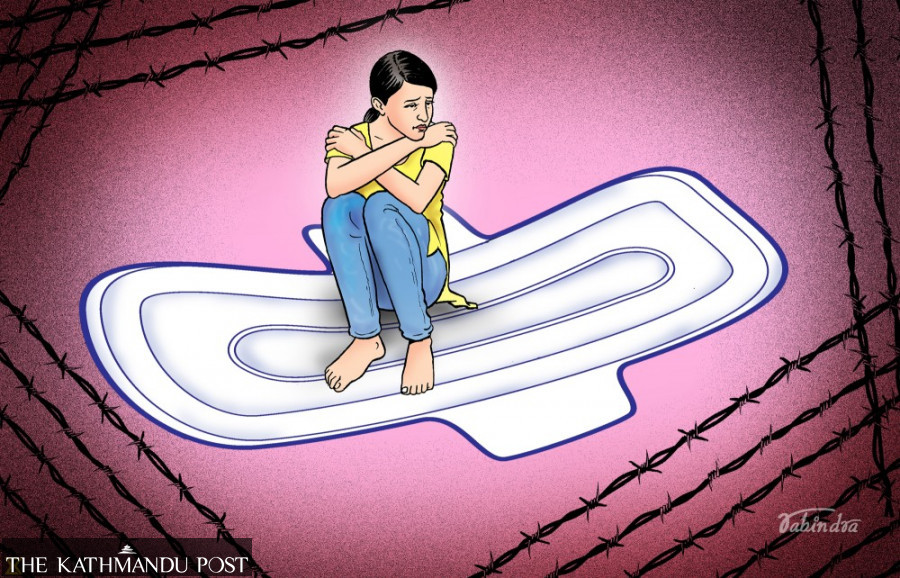National
Menstrual exclusion practices continue even in modern educated families
The caste and gender hierarchies are designed to control women’s sexuality by regulating their menstruation.
Aakriti Ghimire
When Hritika had her first period at the age of 11, she was barred from leading a normal life—at least for five days.
She was expected to stay within the confines of her room and not look at the male members of the family, she said.
“And in every subsequent period, I was not allowed into the kitchen and puja kotha,” recalled the 20-year-old currently studying in the United States, whom the Post is identifying as Hritika, not her real name, to protect her privacy.
She belongs to a Chhetri family. She left Nepal at the age of 18 for higher education.
Every time she comes back to her parents’ home, her mobility is heavily restricted during menstruation, she said.
“When my brother got sick, my mother blamed me for his sickness. She believed he fell ill because I had looked at him during my first period,” she said. “That made me a sinner!”
Hritika’s is a story many girls and women in Nepal relate to.
Cultural beliefs about women’s lack of purity during menstruation have restricted women’s mobility and participation in normal activities.
While it is women who internalise this notion of ‘impurity,’ the crux of these practices appears to be the protection of men’s virility. This control of women’s sexualities through the regulation of menstruation largely stems from the interconnected gender and caste hierarchies, also termed brahmanical patriarchy in Nepal. This while mostly affects women from the so-called upper caste, it is pervasive in Janjatis and Dalit communities as well.
“Patriarchy that is enforced in a caste-based society is called brahmanical patriarchy. The interconnections of caste hierarchy and gender hierarchy lead to the reinforcement of patriarchy within the caste system,” said Mira Mishra, a professor of Gender Studies at Tribhuvan University.
Brahmanical patriarchy is a term coined by Uma Chakravarti, a feminist historian at the University of Delhi, in 1993. The caste system forms the basis of social hierarchies in Nepal, and that is why brahmanical patriarchy is prevalent.
Caste discrimination is as much a reality today in Nepal, as it was 50 years ago; Dalits still face injustice, ostracisation, and violence because of their caste.
In such a caste-based hierarchy, for an individual to be considered ‘pure’ upper-caste, the lineage has to be ‘pure’. In order to maintain such purity, a patriarchal society tries to control women and their sexuality through menstruation, believes Mishra.
“Caste purity is essential in a caste-based society to maintain the superiority and influence of one caste over the other. This caste-purity is reflected by blood purity,” said Mishra.
For example, the child of two pure-blood Brahmins is considered a pure-blood upper caste Brahmin.
“The blood of the child born must be pure to maintain caste purity. And the best way to maintain the purity of caste is by controlling women’s sexuality. Now, how do you control that? You do so by regulating women’s menstruation,” says Mishra.
Menstruation is the focal point in brahmanical patriarchy because it signifies the girls’ fertility and their capacity to bear, which is crucial to maintaining the caste-based hierarchies.
“Menstruation then becomes a gateway to caste-purity,” said Mishra. “To ensure you have a pure lineage, you control a woman’s menstruation. Subsequently, you regulate women’s interactions, their mobility, and ultimately their marriage partners and fathers to their children. Hence, you have a system that is self-regulated by women when you refer to them as nachhune during menstruation, or sinners when they overstep their boundaries.”
The need for such caste purity draws into the language surrounding menstruation.
Impure. Nachhune – untouchable. Words that strip women of their dignity are used while referring to them while menstruating.
The concepts of purity and pollution, fear of gods, and protecting the masculinity of men have been attached to menstruation, so the whole patriarchal caste-based society collectively works in regulating it.
The lineage of a family continues through the male members – in the patrilineal society – and to keep the lineage pure, the protection of men’s virility becomes crucial. The idea of this impurity is then framed as a concern for men or boys, and is enforced by regulating the mobility of menstruating women, according to Mishra.
An additional layer of the fear of gods is coupled with this language of impurity, labeling anyone who refuses the restrictions as a sinner.
“Once you have that fear of god in place, people are willing to do everything and anything. It becomes a very easy policy to enforce and if any woman defies these restrictions, she commits a sin,” said Nitika Sharma, lecturer of Ethnic Studies at Northern Arizona University.
When any defiance of menstrual restrictions becomes equivalent to a sin, women internalise their menstrual impurity and begin the process of self-regulation.
“When women internalise they are impure because of their vaginal bleeding, it places the burden of ostracising themselves upon them,” said Sharma. “Then, women self-regulate their mobility and interactions, not just during menstruation, but at all times.”
As opposed to taking ownership of their bodies, women are brought up to control and regulate their own sexualities.
Sharma describes this phenomenon as the “transferral of the responsibility of keeping the caste-system in check by using women as the gatekeepers of the system.”
Women then reinforce these practices for themselves and other women in the family, as observed in Hritika’s family.
While younger women direct their anger at their mothers for imposing these restrictions on them, the mothers are simply performing their duties in transferring the patriarchal learning to their daughters, experts say.
Having faced the brunt of patriarchal expectations, women aim to smoothen the transition that their daughters will have to go through after marriage, according to Mishra.
“It is the mother’s responsibility to maintain the traditions within their household. If they do not abide by these norms, their positionality in their family will be threatened,” she said.
While at face value, it might seem that brahmanical patriarchy is only relevant to Brahmins and Chhetris, research shows that ‘lower-caste’ groups have historically emulated the rituals and practices of the ‘upper’ or dominant castes seeking upward mobility in the caste hierarchy.
Non-Hindus, Janajati groups, ‘low castes,’ and Dalits, who did not practise menstrual seclusion in the manner that “high-caste” Hindus do, have gradually adopted these practices through a process called ‘Sanskritisation’ in Nepal, said Samira Luitel, professor of Sociology at Tribhuvan University.
This adoption of menstrual rituals practised by many non-Hindu groups makes brahmanical patriarchy a concern for everyone.
Akriti Shrestha hails from a Hindu Newa family, belonging to the Janajati community. As a native of Kathmandu, Shrestha is perplexed by the differences in menstrual exclusion practices in her paternal and maternal families.
“I don’t recall my mother ever excluding herself from the kitchen in my paternal family, even though we lived with our grandparents, and I haven’t had to do so as well,” she said. “But ever since my grandfather passed away, a few months ago, we have been observing strict exclusion to ensure purity in our religious and cultural observances.”
However, in Shrestha’s maternal family, menstrual exclusion practices are extremely strict. “I don’t understand how my grandparents of two families, of the same generation from the same geographical area, had such different approaches to menstruation,” she said.
Sanskritisation is a process that takes place over generations. Women, of all castes, are most affected by this process that reinforces brahmanical patriarchy in all other caste groups.
Lower castes are generally more liberal in their codes towards women but the imitation of upper caste rituals has resulted in harshness towards Hindu Dalit women, particularly.
“Every menstrual cycle at home, we practise strict exclusion – from our own beds, kitchen, living room. First periods begin in dark rooms without sunlight, in some relative’s homes” said Archana Pariyar, a 22-year-old Hindu Dalit. “What’s infuriating is that, during each cycle, I was cautioned against touching my brothers and father, and even sharing food with them.”
Even in the most ‘educated’ and liberal households, brahmanical patriarchy is observed through various menstrual exclusion rituals.
It is commonly believed that women’s education will contribute greatly to eradicating such exclusionary practices.
Despite Hritika’ mother’s educational certificates—her mother holds a PhD—
her beliefs haven’t changed.
“The cultural norms that define her existence are beyond her education and these traditions shape her social life heavily,” said Hritika.
A comparative statistical analysis of Nepal Multiple Indicator Cluster Survey 2014 and 2019 – studies that monitor the situation of women and children in Nepal – indicates that despite women’s education levels, they religiously practise moderate forms of menstrual exclusion rituals: seclusion from religious spaces, their own beds, kitchen, shared bathroom.
Women with higher education levels secluded themselves the most from religious spaces and eating spaces during menstruation, and these practices are prevalent in both urban and rural spaces all across Nepal, according to the survey.
Education hasn’t completely eradicated the practice of these traditions, but it has played a crucial role in normalising it to a certain extent.
“Women of the oldest generation – grandmothers – have internalised menstruation as impure, but the mothers’ generation and daughters’ generation have defied many practices,” said Mishra.
Chetana Panta, 23, whose neither parents underwent formal education, didn’t practise menstrual exclusion in the kitchen or other social spaces because her mother didn’t ask her to. But she doesn’t enter the temple in her home or partake in religious settings.
That core belief of ‘impurity’ during menstruation, however, hasn’t been destroyed at all.
“Many women have entered the kitchen and yet they will not enter any religious spaces during these times. They are willing to consider themselves pure in any other space beyond the religious space, and that reflects my belief too,” said Luitel.
Sharma shared a striking insight with her PhD thesis which indicates that Hindu women of Nepali diaspora settled in ‘liberal’ Western nations, the US and the UK, also practice menstrual exclusion in a similar manner.
Brahmanical patriarchy, thereby, systemically denies women autonomy over their own bodies and menstrual cycles. It affects Nepali women of all castes all across the country.
Recognising these practices of menstrual restrictions as sexual and gender-based violence, the Dignified Menstruation Day is observed every year on December 8 in Nepal and across the world.
This also coincides with the 16 Days of Activism against Gender-Based Violence observed from November 25 to December 10 every year.
“My mother has deeply ingrained these notions of purity. None of the women around her question it. That’s the cultural burden that she has grown up with and internalised. They are practising what they have been taught,” said Hritika.
“At this point, we have to teach our mothers that we shouldn’t practise such customs.”




 12.12°C Kathmandu
12.12°C Kathmandu















